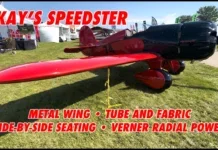 It’s considered bad form—but a whole lot of fun—to line up five friends along runway 27 at Oshkosh, each with a large piece of cardboard with a number on it—a number from 0 to 10. Ideally, put a “6” on a card – that give you the option of giving an arrival a “9” ….or the dreaded “6”, without having to keep track of any more cards. Like I said—fun, but not necessarily kind!
It’s considered bad form—but a whole lot of fun—to line up five friends along runway 27 at Oshkosh, each with a large piece of cardboard with a number on it—a number from 0 to 10. Ideally, put a “6” on a card – that give you the option of giving an arrival a “9” ….or the dreaded “6”, without having to keep track of any more cards. Like I said—fun, but not necessarily kind!
Watching the arrivals on either of Oshkosh’s two runways on a Saturday or Sunday is a great lesson in just how traffic can be managed to make a mid-sized airport the busiest field in the world for a week. And it will also give you a huge lesson in how to fly an approach and touch down precisely on speed and on a spot… or not! It’s generally accepted that it is easier and faster to learn by watching other people make mistakes than to make them yourself; How do you think instructors become so good? And watching the arrivals for just an hour will show you a wide range of “techniques,” some good, some not so good, and some where you just might close your eyes and hope you don’t hear a crunch.
A couple of things to watch for:
- Those that are behind the power curve and dragging it in to hit their designated spot. It’s very obvious when you see a high pitch attitude and lots of power. Firm touchdowns right on the spot are the reward—if you don’t stall first!
- Fast approaches followed by the endless float, especially with low wing airplanes. Some pilots are concerned enough about the base-to-final stall spin that they carry an extra ten knots around on the final, and can’t figure out how to get rid of it before they get into ground effect and slide right past their designated spot.
- The bounce. This occurs when the pilot is so determined to hit their spot that they do! But the airplane isn’t ready to quit flying, so it leaps right back into the air. At this point, you add power and go around, or try and tame the beast without getting into a porpoise. The porpoise is most likely if you’re not close to a normal touchdown speed.
If you haven’t guessed yet, the best approaches are on speed, with steady power to get to the right spot; followed by a nice flare and maybe a slightly firm arrival to make sure you’re planted. After all – there are other guys on final with you, each one aiming for a spot – so don’t take theirs!
Spend an hour or two! It might be the best landing instruction you ever get.













